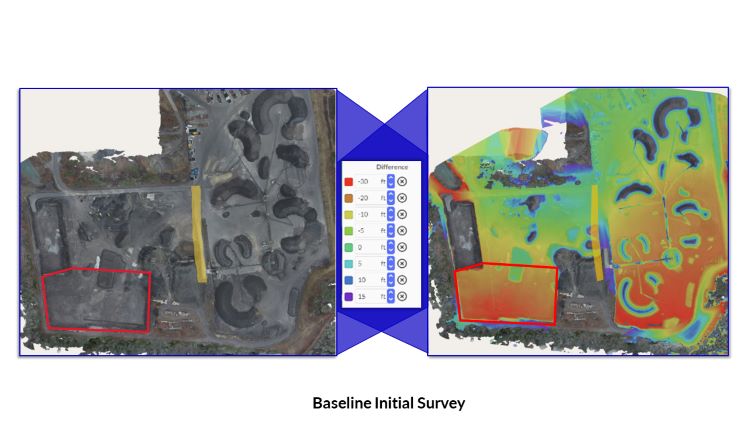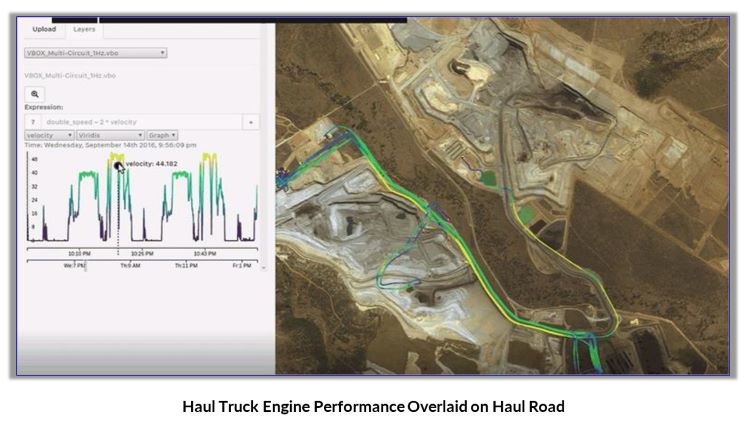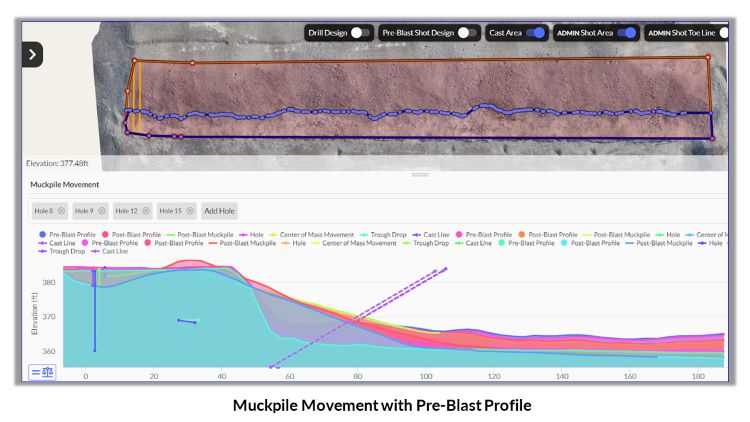Taking Control: 4 Reasons to Invest in Floor Control
Why Floor Control is so Important for Mining Operations
Pit floors need to meet design specifications. Even though we all know this, it sometimes helps to revisit why.
When addressing the issue of an uneven floor, or looking to maintain a certain grade to keep a pit floor level, monitoring the elevation on a frequent basis will allow operations to identify issues as they arise. By combining drone data with AI, variations in the floor can be automatically identified and quantified with every drone flight. If your operations are using a single site intelligence solution (like Strayos) then the floor control surveys can be combined and compared with other data sets like drill data, haul road grades, loading intelligence, and more.
By failing to invest in floor control initiatives operations can suffer significant financial losses due to production loss from inefficient haul cycles, excess equipment wear, and difficulty in further bench development.
Losing Control
Since elevation changes are not always clear to the naked eye, operations oftentimes don’t even know they are suffering losses. Even if they suspect they may be losing money due to poor floor control, it can be nearly impossible to pinpoint the cause of the poor floor control, identify the extent of the problem, and implement corrective actions. However, all of these issues can be easily addressed by simply flying the site with a drone and analyzing the floor elevations.

Here, using photogrammetry to create 3D models with elevation heat maps, we can clearly see upwards of a 30 foot elevation change from where the drill and blast operations are occurring (red polygon) to the haul road leading to the primary crusher (yellow highlight). Now that we have realized the extent of the issue and are able to quantify it, we can determine the impacts it has had on the operations, identify the cause, and take steps to not only correct the issue but proactively prevent future loss of floor control.
1. Excess Fuel Consumption
Pit floor undulations and high bottom cause poor engine performance that results in unnecessary excess fuel consumption and increased emissions in haul trucks and loaders. Loaders need to work harder to penetrate material piles and navigate uneven floors. An unintended slope gaining depth as the pit progresses creates additional engine work and slow haul routes.
In addition to floor control tools, Haul Road analyses can be used to identify and remediate trouble spots then optimize engine performance and minimize fuel consumption. These analyses identify road grades where haul trucks may need to gear down to power up the grade while loaded with material can be addressed. Adding engine performance data visualizations can further clarify areas that need improvement. See more information on Haul Road analysis here

2. Production Loss
Where uneven floors directly affect loading and hauling, we see inefficient cycle times in loading material and then in hauling the material from site to mill.
Decreased Productivity due to reduced dig-ability
Undulations in the pit floor can significantly increase dig times as operators are forced to work through or around areas of high bottom. Dig times increased by as little as 10% can result in massive productivity losses of tens of thousands if not millions of dollars per site. These rough estimates do not include issues that arise from other loading inefficiencies and downstream effects including reduced bucket penetration from bucket and tooth wear, delaying blasts, and mill shutdowns from lost teeth.
Decreased Productivity do to increased haul truck cycle times
Average Haul Truck Cycle Times: 300 seconds
10 hour cycle time = 120 trips to Primary CrusherIncreased time due to floor issues: 345 seconds
10 hour shift: 104 trips to primary = 14% lossProduction Loss: Potentially 4,800 tons of material per day
In a 300 ton haul truck, a difference of 16 trips to a primary crusher = 4,800 tons of material per day loss of production.
By addressing these floor control and grade issues, we can improve loading times and truck cycles, saving money on the bottom line.
3. Increased Equipment Wear & Tear
Aside from increased fuel costs and reduced productivity, additional unnecessary operational expenses of poor floor control include excess wear on tires, suspensions, and digging equipment.
When there are uneven floors we see a direct correlation to excess bucket and tire wear when digging material. High bottom wears down buckets and teeth and frequently results in lost teeth.
Excavator and Loader bucket costs can run from $10-20K;
Bucket teeth cost a few hundred dollars depending on size- but can be needed to be replaced as often as monthly in poor conditions
Not only is there an additional cost from frequent repairs and replacements, but the costs ancillary to worn buckets and teeth- including lost productivity, replacement parts, and even losing teeth in crushers- often inspires companies to invest in additional wear monitoring and mitigating technologies.
Excess tire wear is a direct cost associated with hauling in rough floor conditions, decreased dig-ability and high bottom require tires to exert greater force and may even spin as the machine tries to penetrate the material it is loading. With costs of haul truck tires approaching $5,000 or more, it is essential to maintain the conditions that the fleets run in.
By addressing the root cause of the problem- poor floor control- equipment monitoring and replacement costs can be nipped in the bud.
4. Added Drilling Costs
When planning to do any benching, drilling through additional broken rock from previous shots above bench grade can add significantly more time and difficulties to the operation. Since drilling costs make up the majority of Drill & Blast operational expenses, excess drilling can be a significant source of excess expense.
Managing Drill Cost While Reducing Excess Production:
Cost of drill per hour= $500
Baseline shot: 36 hours of operation $18,000
Footage in shot 4,000 (100 holes @ 40 feet)
Drill feet per hour: 111’Drilled 2 extra feet in each hole (200 extra drill feet in shot)
Almost 2 additional hours of drilling ($1000 added cost)
Bench Shot Below (same geometry):
Due to added broken rock on the surface from additional 2’ Drill production reduced from 111’ per hour to 100’.
Total production time to drill shot:40 hours (additional $2000 dollars)
Taking Back Control
The trick to taking back control of your floor begins with measuring the problem. This can be easily identified and quantified using drone photogrammetry within an AI software like Strayos. But identifying the problem is only the first step, next an operation needs to take steps to correct the issue AND proactively prevent future loss of floor control by identifying and addressing the root cause- poor blast outcomes.
By incorporating drill and blast design data to the floor plane we can identify areas of high bottom and uneven floors then compare it to D&B operations data and the shots they correlate to. Seeing what went wrong and comparing it to the records allows operations to perform QA/QC on drill and blast operations to improve performance and prevent floor control issues and many of the associated costs detailed in this article.

Key D&B points to pay attention to to minimize floor control issues:
Here, we see a bench that was shot out in a quarry. After flying the site post blast, and overlaying the existing shot plan, we can see the resulting floor conditions. Due to the visual of high and low spots, we can see which holes might have not been drilled to depth or where wet hole conditions could have sacrificed explosive performance at the bottom of the column. Here, we see elevation changes in excess of 6 to 8 feet along the bench from desired grade. Learn more about Strayos' Floor Control tool


New technologies are rapidly changing the drilling, blasting, mining, and aggregates industries, empowering them in ways never before possible. Make sure you are taking advantage of the best tools available.
Check out our 2 Free E-books on AI applications for the drilling, blasting, and mining industries to see all the amazing advances that are available.
AI Guide for Drilling and Blasting
AI Guide for Mining
Watch our videos:
YouTube


